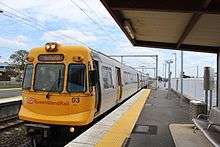Queensland Rail
|
| |
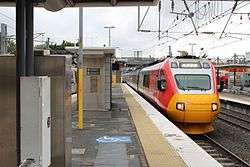 Diesel Tilt Train at Bowen Hills in September 2016 | |
| Industry | Railway operator |
|---|---|
| Founded | 31 July 1865 |
| Headquarters | Brisbane, Queensland, Australia |
Area served | Queensland |
Key people |
Nick Easy (CEO) Phillip Strachan (Chairman) |
| Revenue | $1,881 million (2016/17) |
| $325 million (2016/17) | |
| $101 million (2016/17) | |
Number of employees | 6,520 (June 2017) |
| Parent | Queensland Government |
| Website |
queenslandrail |
Queensland Rail, also known as QR, is a railway operator in Queensland, Australia. Owned by the Queensland Government, it operates suburban and long-distance passenger services, as well as owning and maintaining approximately 6.600 kilometres of track.
QR also was responsible for all Queensland freight services and from 2002 operated interstate services under the Australian Railroad Group, Interail and QR National brands. These were all spun out into a separate entity in July 2010 and later privatised as Aurizon.
History
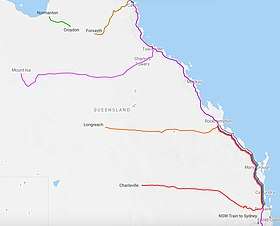
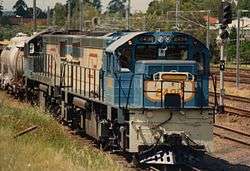
Beginnings
Queensland Railways was the first operator in the world to adopt narrow gauge (in this case 1,067 mm (3 ft 6 in)) for a main line,[1] and this remains the systemwide gauge within Queensland today.
The colony of Queensland separated from New South Wales in 1859, and the new government was keen to facilitate development and immigration. Improved transport to the fertile Darling Downs region situated west of Toowoomba was seen as a priority. As adequate river transport was already established between the capital Brisbane and the then separate settlement of Ipswich, the railway commenced from the latter locality and the initial section, built over relatively flat, easy country opened to Bigge's Camp, at the eastern base of the Little Liverpool Range, on 31 July 1865. Called the Main Line, the only significant engineering work on that section was the bridge over the Bremer River to North Ipswich.
Tunneling excavation through the Little Liverpool Range delayed the opening of the next section to Gatton by 10 months, but the line was opened to Toowoomba in 1867, the ascent of the Main Range being the reason for the adoption of narrow gauge.
Built by the Queensland Government to the unusual (for the time) gauge of 1,067 mm (3 ft 6 in), the line largely followed the alignment surveyed by a private company, the Moreton Bay Tramway Company, which had proposed to build a 1,435 mm (4 ft 8 1⁄2 in) horse-drawn tramway but had been unable to raise funds to do so beyond an initial start on earthworks.
The adoption of narrow gauge was controversial at the time, and was largely predicated by the government's desire for the fastest possible construction timeframe at least cost.[2] This resulted in adoption of sharper curves and a lower axle load than was considered possible using standard gauge, and an assessment at the time put the cost of a narrow gauge line from Ipswich to Toowoomba at 25% of the cost of a standard gauge line. In a colony with a non-indigenous population of 30,000 when the decision was made, it is understandable.
The network evolved as a series of isolated networks. It wasn't until the completion of the North Coast line in December 1924 that all were joined.[3] The exception was the Normanton to Croydon line which always remained isolated. At its peak in 1932, the network totaled 10,500 kilometres.
Changing transport patterns resulted in the closure of many development branch lines from 1948 onwards, but at the same time the main lines were upgraded to provide contemporary services, and from the 1970s an extensive network of new lines was developed, particularly to service export coal mines.
Electrification

Commencing in November 1979 the Brisbane suburban network was electrified.
In 1978, discussions were commenced on possible electrification of the Blackwater and Goonyella coal networks. This was due to an expected increase in coal traffic across the networks, ageing diesel-electric locomotive fleet and the increase in diesel fuel costs. By early 1983, a decision had been made to electrify the networks and by early 1984 contracts were already starting to be let for the new locomotives and other works for the project. The decision was made to electrify with the 25 kV AC railway electrification system as used on the Brisbane suburban network. This would allow future connection of the Brisbane network with the coal networks via the North Coast line.
The project was to be carried out in four stages:[4]
Stage 1: Electrification of the main line from Gladstone to Rockhampton, including parts of Rockhampton marshalling yard, then west to Blackwater and the coal mines in the area. This was a total of 720 kilometres (450 mi) of track.
Stage 2: Electrification of the coal lines south of Dalrymple Bay and Hay Point, then west through the Goonyella system, south-west to Blair Athol and south to Gregory – linking the Goonyella system to the Blackwater system. This was a total of 773 kilometres (480 mi) of track.
Stage 3: Electrification of the main western line from Burngrove to Emerald. This would allow electric freight from Rockhampton to Emerald.
Stage 4: Electrification of the line from Newlands coal mine to Collinsville and north-east to Abbott Point. This stage never went ahead. In 1986 it was decided to electrify the North Coast line between Brisbane and Gladstone instead and this became known as Stage 4.[5][6]
Interstate expansion
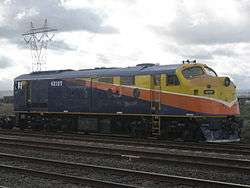
In September 1999 Queensland Rail was rebranded as QR.[7] In March 2002 Queensland Rail purchased Northern Rivers Railroad and rebranded it Interail, fulfilling a long-held ambition of to expand beyond its state borders.[8][9]
In March 2003 Queensland Rail entered the Hunter Valley coal market when Interail commenced a contract from Duralie Colliery to Stratford Mine. Another coal contract was won in late 2003 for the haulage of coal from Newstan Colliery, Fassifern to Vales Point Power Station. In 2004 Interail began running Brisbane to Melbourne and Sydney to Melbourne intermodal services. In June 2005 Queensland Rail acquired the CRT Group.[10]
In June 2006 the Western Australian business of the Australian Railroad Group was purchased.[11][12][13]
Privatisation and current era
In June 2009 the Queensland Government announced the privatisation of Queensland Rail's freight business.[14][15] This resulted in Queensland Rail's freight assets being transferred to QR National (now Aurizon) from 1 July 2010.
In April 2013 the Queensland Parliament passed the Queensland Rail Transit Authority Bill 2013 that restructured Queensland Rail.[16] The explanatory notes published for the bill outlined that the existing Queensland Rail Limited entity would remain although no longer be a Government Owned Corporation and that entity would become a subsidiary of a new Queensland Rail Transit Authority (QRTA), in effect creating a Queensland Rail group. Under the revised arrangements Queensland Rail Limited retained assets and liabilities and staff were transferred to the QRTA.[17] As a result of transferring the staff to the QRTA, the government moved those employees from the federal industrial relations system to the state based industrial relations system, giving the state more control over industrial arrangements.[17] [18] In November 2013 five labor unions commenced legal proceedings in the High Court of Australia alleging that the QRTA was subject to the federal industrial jurisdiction rather than the state system. [18] In April 2015 the court ruled the QRTA was subject to the Fair Work Act 2009 and the federal industrial relations jurisdiction.[19]
Company Officers
Commissioners
The Commissioners of the Queensland Railways were:
- 23 December 1863 – October 1864: Abraham Fitzgibbon[20][21]
- 28 October 1864 – 29 April 1869: Arthur Orpen Herbert[22][23]
Note: from 29 April 1869 to 15 July 1870, the Secretary for Public Works was appointed Commissioner for Railways.[23][24]
- 15 July 1870 – 12 March 1885: Arthur Orpen Herbert[24][22]
- 12 March 1885 – 29 July 1889: Francis W. Curnow[22]
Note: from 29 July 1889 a Board of three Commissioners was appointed to reduce political influence.[25] This was reduced back to a single Commissioner in September 1895.[26]
- 29 July 1889 – 30 June 1896: John Mathieson (Chief Commissioner)[22]
- 29 July 1889 – September 1895: Robert John Gray (1st Assistant Commissioner)[22]
- 29 July 1889 – 13 December 1894: Andrew Johnston (2nd Assistant Commissioner)[22]
- 1 July 1896 – 30 September 1902: Robert John Gray[22]
- 5 November 1902 – 24 March 1911: James Forsyth Thallon[22]
- 30 March 1911 – 31 May 1911: Thomas Mulhall King[22]
- 1 June 1911 – 31 October 1918: Barnard Charles Evans[22]
- 1 November 1918 – 28 February 1938: James Walker Davidson[22][27]
- 1 March 1938 – 28 February 1941: Curteis Anthony Murton[28]
- 9 March 1941 – 27 February 1948: Percy Robert Turner Wills[29]
- 1 March 1948 – 31 August 1952: Timothy Edward Maloney[30]
- 1 September 1952 – 31 August 1962: Gerald Vincent Moriarty[31]
- September 1962 – 4 July 1976: Alva George Lee[32]
- 5 July 1976 – 17 December 1982: Percy James Goldston[33][34]
- 13 January 1983 – April 1986: Douglas Vernon Mendoza[35][36]
- 20 May 1986 – 31 July 1989: Ralph T. Sheehy[37][38]
- 1 August 1989 – December 1989: Ross William Dunning[39][40]
- December 1989 – 7 October 1990: Robin G. Read (Acting Commissioner)[40][41]
- 8 October 1990 – 30 June 1991: Vincent John O'Rourke[41]
Note: from 1 July 1991 the position of Commissioner for Railways ceased to exist, replaced by a Chief Executive Officer, reporting to a board of Directors.[42]
Chief Executive Officers
| Name | Tenure | Notes | |
|---|---|---|---|
| Vincent John O'Rourke | July 1991 - December 2000 | ||
| Bob Scheuber | December 2000 - April 2007 | ||
| Stephen Cantwell | April 2007 - November 2007 | ||
| Lance Hockridge[43] | November 2007 - 30 June 2010 | ||
| Paul Scurrah | 01 July 2010 - 02 December 2011[44] | From formation of revised Queensland Rail entity following Public float of QR National. Previously Executive General Manager of QR Passenger subsidiary.[43] | |
| James Benstead | December 2011 - August 2013 | ||
| Glen Dawe | August 2013[45] - January 2014[46] | ||
| Helen Gluer | 03 April 2014 - 27 October 2016[47] | ||
| Neil Scales | October 2016 - March 2017 | ||
| Nick Easy | March 2017[48] - |
Services
City network
QR operates urban and interurban rail and bus services throughout South East Queensland as part of the TransLink network. Rail services operate on twelve lines; Beenleigh, Caboolture, Cleveland, Doomben, Exhibition, Ferny Grove, Gold Coast, Ipswich-Rosewood, Redcliffe Peninsula, Shorncliffe, Springfield and Sunshine Coast. QR operate these with the Electric Multiple Units (EMU), Suburban Multiple Units (SMU), Interurban Multiple Units (IMU),InterCity Express (ICE) and New Generation Rollingstock (NGR) class electric multiple units.[49]
Due to low patronage, the Corinda to Yeerongpilly and Dombden to Pinkenba lines have had their services replaced by buses, while due to capacity constraints, services on the Sunshine Coast between Caboolture and Nambour are supplemented by a bus service.
Long-distance trains
Queensland Rail operate these long-range passenger rail services[50]
- Electric Tilt Train: Brisbane to Rockhampton
- Spirit of Queensland: Brisbane to Cairns
- Spirit of the Outback: Brisbane to Longreach
- The Inlander: Townsville to Mount Isa
- The Westlander: Brisbane to Charleville
Connecting road coach services are operated.[51]
Annual patronage for these services in 2011/12 was 795,000.[52] In 2007/08, the subsidy for the Brisbane-Cairns route was $130 million, or $900 per passenger. In 2001/02 it was $270 million.[53][54]
Tourist trains
Queensland Rail also operate these tourist trains:[50]
Former services
Queensland Rail operated many named trains including:
- Capricornian: Brisbane to Rockhampton, operated from 1970 until 1993 when replaced by the Spirit of the Outback
- Great South Pacific Express: luxury train operated from 1999 until 2003[55]
- The Midlander: Rockhampton to Winton, operated from 1954 until 1993 when replaced by the Spirit of the Outback
- Savannahlander: Cairns to Forsayth, operated from 1995 until 2004 when contracted out to a private operator[56]
- Spirit of Capricorn: Brisbane to Rockhampton, operated from 1988 until 2003
- The Sunlander: Brisbane to Cairns, operated from 1953 until 2014 when replaced by the Spirit of Queensland[57]
Rolling stock
QR sourced steam locomotives from many manufacturers including Armstrong Whitworth, Avonside Engine Company, Beyer, Peacock & Company, Dübs & Co, Kitson & Co, Nasmyth, Wilson & Co, Neilson and Company, North British Locomotive Company, Vulcan Foundry and Yorkshire Engine Company all of the United Kingdom, Baldwin Locomotive Works of the United States, as well as Australian manufacturers Clyde Engineering, Evans, Anderson, Phelan & Co, Islington Railway Workshops, Newport Workshops, Phoenix Engine Company, Toowoomba Foundry and Walkers Limited. It also built some in-house at North Ipswich Railway Workshops.[58]
Dieselisation commenced in 1952 with early purchases being imported from GE Transportation and English Electric, before standardising on locally made products from A Goninan & Co, Clyde Engineering, English Electric and Walkers Limited. Electric locomotives were purchased from Clyde Engineering, Walkers Limited and Siemens. Electric multiple units have been purchased from Walkers Limited, Downer Rail and Bombardier Transportation.
Fleet
| Class | Image | Type | Top speed (km/h) | Built | Number of units | Routes operated | Notes |
| Current City network fleet | |||||||
|---|---|---|---|---|---|---|---|
| EMU00 |  |
Electric multiple unit | 100 | 1979–1987 | 87 | City network | Planned to be progressively retired from 2018. |
| ICE150 | 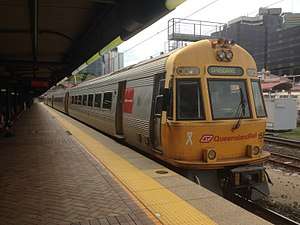 |
Electric multiple unit | 120 | 1988–1989 | 8 | City network (Sunshine Coast line only) | Planned to be progressively retired from 2018. |
| SMU200 | 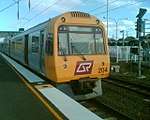 |
Electric multiple unit | 100 | 1994–1995 | 12 | City network | Planned to replace the EMU units as the trains primarily used on lines throughout the city. |
| IMU100 | 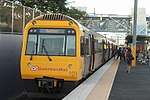 |
Electric multiple unit | 140 | 1996–1997 | 10 | City network | |
| SMU220 | 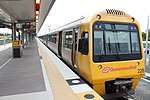 |
Electric multiple unit | 100 | 1999–2001 | 30 | City network | Planned to replace the EMU units as the trains primarily used on lines throughout the city. |
| IMU120 | 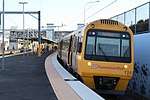 |
Electric multiple unit | 140 | 2001–2002 | 4 | City network | |
| IMU160 | 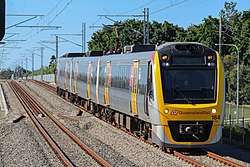 |
Electric multiple unit | 130 | 2004–2011 | 28 | City network | |
| SMU260 | 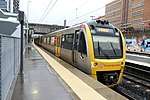 |
Electric multiple unit | 130 | 2008–2011 | 35 | City network | |
| NGR700 | 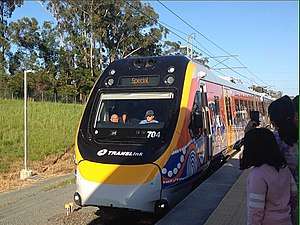 |
Electric multiple unit | 140 | 2015–2018 | 19 (July 2018)[59] | City network | 75 on order |
| Locomotive fleet1 | |||||||
| DL class | 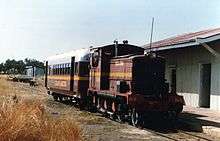 |
Diesel locomotive | 50 | 1961 | 1 | DL4 backup for the Gulflander. | |
| 1720 class | Diesel locomotive | 100 | 1966–1970 | 15 | Kuranda Scenic Railway, Traveltrain services and infrastructure trains. | ||
| 2150 class | Diesel locomotive | 100 | 1966–1970 | 6 | Traveltrain services and infrastructure trains. | ||
| 2400 class | Diesel locomotive | 100 | 1966–1970 | 5 | Traveltrain services and infrastructure trains. | ||
| 2470 class | Diesel locomotive | 100 | 1980–1983 | 5 | Traveltrain services and infrastructure trains. | ||
| Traveltrain fleet | |||||||
| Electric Tilt Train | 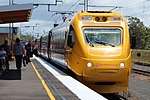 |
Tilting electric multiple unit | 160 | 1997 | 2 | North Coast line | |
| Diesel Tilt Train | Tilting diesel multiple unit | 160 | 2003, 2014 | 3 | North Coast line | ||
| Tourist train fleet | |||||||
| 45 hp rail motor | 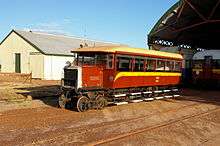 |
Railmotor | 40 | 1931 | 1 | Based at Normanton, used for charters. | |
| 102 hp rail motor | 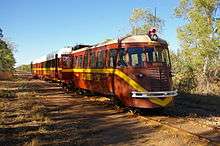 |
Railmotor | 50 | 1950 | 1 | Gulflander | |
| 1800 class |  |
Railmotor (trailers) | 50 | 1952–1954 | 2 | Gulflander | |
| Heritage fleet | |||||||
| A10 class | Steam locomotive | 40 | 1865–1866 | 1 | No. 6 operational, Australia's oldest operational steam locomotive. Usually placed on display at the Workshops Rail Museum when not required for special trains. | ||
| PB15 class | Steam locomotive | 65 | 1899–1926 | 1 | 732 being overhauled. | ||
| C17 class | Steam locomotive | 80 | 1920–1953 | 2 | 974 operational, 1000 being restored to working order. | ||
| DL class | Diesel locomotive | 50 | 1939 | 1 | On display at the Workshops Rail Museum. | ||
| AC16 class | Steam locomotive | 80 | 1943 | 1 | 221A operational. (USATC S118 Class) | ||
| DD17 class | Steam locomotive | 80 | 1948–1952 | 1 | 1051 restored to working order, currently under heavy overhaul. | ||
| Beyer-Garratt | Steam locomotive | 80 | 1950–1951 | 1 | 1009 stored pending overhaul | ||
| BB18¼ class | 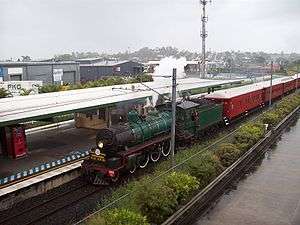 |
Steam locomotive | 80 | 1950–1958 | 2 | 1079 and 1089 operational. | |
| 1150 class | Diesel locomotive | 80 | 1952 | 1 | 1159 stored pending restoration. | ||
| 1400 class | Diesel locomotive | 80 | 1955 | 1 | 1407 stored pending restoration. | ||
| 1170 class | 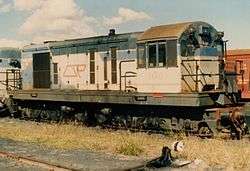 |
Diesel locomotive | 80 | 1956 | 1 | 1170 stored pending restoration. | |
| 1900 class | 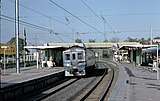 |
Railmotor | 80 | 1956 | 1 | 1901 operational, also used as a track inspection vehicle. | |
| 2000 class | 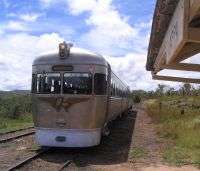 |
Railmotor | 80 | 1956–1971 | 6 | 2034, 2036 and 2057 operational, also used as inspection vehicles. 2005, 2024 and 2031 stored. | |
| 1450 class | Diesel locomotive | 80 | 1957 | 3 | 1450, 1455 and 1459 stored pending restoration. | ||
| 1250 class | Diesel locomotive | 80 | 1959 | 1 | 1262 on display at Workshops Rail Museum. | ||
| SX carriages | Passenger car | 80 | 1961–1962 | 7 | Formed into one 7-car set. | ||
| 1600 class | Diesel locomotive | 80 | 1962 | 1 | 1603 stored pending restoration. | ||
| 1460 class | Diesel locomotive | 80 | 1964 | 1 | 1461 stored pending restoration. | ||
| 1270 class | Diesel locomotive | 80 | 1964 | 2 | 1270 stored pending restoration, 1281 on display at Workshops Rail Museum. | ||
| DH class | Diesel locomotive | 50 | 1966 | 2 | DH2 and DH71 stored. | ||
| 1620 class | Diesel locomotive | 80 | 1967 | 1 | 1620 operational. | ||
| Special cars | |||||||
| Vice-Regal Car | 80 | 1903 | 1 | Car 445 is a special saloon retained for use by the Governor of Queensland and is still considered a working item of rollingstock in the QR fleet, however it is on permanent loan to Workshops Rail Museum.[60] | |||
1 This table only includes locomotives owned by Queensland Rail. QR also hires locomotives from Aurizon as required.
Workshops
From its inception, QR's primary workshops were the North Ipswich Railway Workshops. It was replaced by the Redbank Railway Workshops in the 1960s.
Incidents
Notable incidents involving Queensland Rail include:
- On 15 November 2004, a Diesel Tilt Train VCQ5 derailed at Berajondo on the North Coast line due to excessive speed resulting in injuries to over 100 people.[61]
- On 31 January 2013 a passenger train failed to stop at Cleveland station and collided with the station building resulting in major damage to the train and minor injuries to a number of people.[62]
Criticism and controversy
Sunlander 14 and Traveltrain Renewal
In December 2014 the Queensland Audit Office published a report about QR's Sunlander 14 project. The Sunlander 14 project had a scope to acquire a total of 25 carriages to replace The Sunlander passenger train with a new Diesel Tilt Train, purchase additional luxury cars for the two existing Diesel Tilt Trains operated by and refurbish their existing carriages.
The project was initially costed at $195 million and allowed for the operation of five services a week. However, costs had risen by 2012, and the Queensland Auditor-General reported that the eventual cost would be from $358 to $404 million, because QR had failed to take into account the requirement for upgraded maintenance facilities, as well as en route provisioning.[63] The Auditor-General also believed, due to issues with the business case that QR had overestimated how popular the new service would be, and had a mistaken belief that the 'luxury' component of the train would attract more high-paying customers.[64]
In 2013 the project was scaled back, with the train length being reduced to nine cars by removing the luxury sleepers and restaurant cars. That resulted in a revised project cost of $204 million. The Auditor-General's report in particular highlighted that due to the fixed-price construction contract the cost per train car increased and that opportunities were missed to pursue broader long distance train fleet renewal.[63]
Redcliffe Peninsula railway line and subsequent driver shortages
The Redcliffe Peninsula railway line opened on 4 October 2016 and created a revised timetable that resulted in a 9% increase in services across the network.[65] Queensland Rail did not have sufficient traincrew to operate the increased services. On 21 October a substantial interruption of service occurred involving the cancellation without notice of 167 services (12% of the scheduled services for the day) due to compulsory rest periods required for the train crew (a break of at least 32 hours required when a crew member has worked 11 consecutive days or 14 consecutive shifts).[65]
Following the service interruptions the head of the train service delivery unit was stood down[66] and an interim timetable implemented that reversed the increase in services and demand for traincrew.[65] Several weeks after the service interruptions Queensland Rail CEO Helen Gluer announced her resignation from the company, along with chairman Michael Klug.[67] It was announced on 27 October 2016, that the Director-General of the Department of Transport and Main Roads, Neil Scales, would replace Helen Gluer and that an inquiry known as the Queensland Rail Train Crewing Practices Investigation would be led by Phillip Strachan into the events.[68]
On 25 December 2016 another substantial service cancellation event occurred due to a lack of available traincrew to operate the services.[69][70] On that day 261 services, or 36% of scheduled services did not operate.[65] The underlying reason for the cancellations was a lack of available drivers to operate services. Queensland Rail's Chief Operating Officer resigned several days later.[70]
The inquiry into Queensland Rail's train crewing conducted by Phillip Strachan was completed in February 2017. The report made a number of findings and provided 36 recommendations that the Queensland Government accepted. The findings included that Queensland Rail had experienced a 9% increase in demand for traincrew due to the revised timetable while also experiencing a 7% decrease in traincrew productivity as a result of revised industrial arrangements, had intentionally operated for a number of years with an under-supply of traincrew and utilised the shortfall to provide paid overtime opportunities, had reduced traincrew intake during 2014-15 in the lead-up to the opening of the new line, had restrictions on external recruitment and had a longer driver training period than like organisations.[65] The report also highlighted unclear governance arrangements and a short term focus within the operations section that relied on intuition rather than accurate forecasting and a reluctance to share bad news as contributing factors.[71][65] The recommendations from the report centered around demand management, supply management, people and process management and governance arrangements.[65]
Following the completion of the Strachan inquiry Philip Strachan was appointed as Chair of the Queensland Rail Board replacing Acting Chair Nicole Hollows[72], who had been appointed following the resignation Michael Klug.[73] A Citytrain Response Unit was established within the Department of Transport and Main Roads to oversee the implementation of the recommendations from the Strachan inquiry.[74] The Citytrain Response Unit subsequently commissioned a whole of business review into the organisation that was conducted by Deutsche Bahn and delivered in July 2017[75] and published reports tracking the progress of the implementation of the recommendations.[76] Executive bonus payments were also suspended for 2017.[77]
See also
References
- ↑ Kerr J 'Triumph of Narrow Gauge', Boolarong Publications 1990
- ↑ "PARLIAMENT". The Brisbane Courier. 18 May 1864. p. 2. Retrieved 4 March 2014 – via National Library of Australia.
- ↑ The North Coast Line The Telegraph 9 December 1924 page 8
- ↑ Queensland Rail (August 1984). "Fact Sheet No.1 August 1984 Everything you should know about Australia's biggest railway project" (1): 1.
- ↑ RW Dunning & AM Drake (c. 1985). "Mainline Electrification" (1): 3.
- ↑ Queensland Rail (February 1986). "Fact Sheet No. 9 Main Line Electrification Project Special Edition" (1): 1.
- ↑ "Queensland Rail Becomes QR and Looks Beyond its Borders" Railway Digest November 1999 page 9
- ↑ "QR moves into NSW with Northern Rivers Railroad buy"". Rail Express. 12 March 2002. Archived from the original on 6 February 2015. Retrieved 16 September 2018.
- ↑ "QR National push". WorldCargo News. March 2002. Archived from the original on 20 December 2016. Retrieved 16 September 2018.
- ↑ Queensland Rail sorts logistics for acquisition Archived 24 March 2014 at the Wayback Machine. The Age 25 June 2005
- ↑ Sale of Australian Railroad Group Archived 5 January 2014 at the Wayback Machine. Wesfarmers 14 February 2006
- ↑ ARG on board Queensland Rail Archived 26 October 2012 at the Wayback Machine. The Age 31 March 2006
- ↑ QR closes national rail freight deal QR National 2 June 2006
- ↑ Queensland asset sales to reap $15 billion Archived 19 October 2009 at the Wayback Machine. Brisbane Times 2 June 2009
- ↑ Premier announces QR Privatisation Plan Archived 15 January 2016 at the Wayback Machine. Railway Gazette International 4 June 2009
- ↑ "Bills 54th Parliament". Queensland Parliament. Retrieved 2018-05-25.
- 1 2 "Queensland Rail Transit Authority Bill 2013 Explanatory Notes" (PDF). Queensland Parliament. 2013. Retrieved 25 May 2018.
- 1 2 "Queensland Rail subject to Fair Work Act". Hall Payne Lawyers. 2015-04-08. Retrieved 2018-05-25.
- ↑ "COMMUNICATIONS, ELECTRICAL, ELECTRONIC, ENERGY, INFORMATION, POSTAL, PLUMBING AND ALLIED SERVICES UNION OF AUSTRALIA & ORS v QUEENSLAND RAIL & ANOR [2015] HCA 11" (PDF). High Court of Australia. 8 April 2015. Retrieved 25 May 2018.
- ↑ "THE GAZETTE". The Courier (Brisbane). XVIII (1825). Queensland, Australia. 30 December 1863. p. 2. Retrieved 28 December 2016 – via National Library of Australia.
- ↑ "SUPREME COURT". The Brisbane Courier. XIX (2, 122). 17 November 1864. p. 5. Retrieved 28 December 2016 – via National Library of Australia.
- 1 2 3 4 5 6 7 8 9 10 11 "RAILWAY COMMISSIONERS". The Brisbane Courier. 28 July 1924. p. 37 Supplement: Queensland's Centenary. Retrieved 22 June 2015 – via National Library of Australia.
- 1 2 "Queensland Government Gazette". 10 (39). 1 May 1869: 547.
- 1 2 "Queensland Government Gazette". 11 (66). 16 July 1870: 846.
- ↑ Kerr, John (1998). Triumph of Narrow Gauge. Brisbane: Boolarong Publications. p. 90. ISBN 0 86439 204 4.
- ↑ "Parliament". Darling Downs Gazette. 23 September 1895. p. 5. Retrieved 18 August 2018.
- ↑ Weekly Notice No.8/38. Queensland Railways. 24 February 1938. p. 1.
- ↑ Weekly Notice No.9/41. Queensland Railways. 27 February 1941. p. 1.
- ↑ Weekly Notice No.7/48. Queensland Railways. 22 April 1948. p. 1.
- ↑ Weekly Notice No.34/52. Queensland Railways. 21 August 1952. p. 1.
- ↑ Weekly Notice No.35/62. Queensland Railways. 30 August 1962. p. 1.
- ↑ Weekly Notice No.26/76. Queensland Railways. 1 July 1976. p. 1.
- ↑ Weekly Notice No.27/76. Queensland Railways. 8 July 1976. p. 1.
- ↑ Weekly Notice No.48/82. Queensland Railways. 16 December 1982. p. 2.
- ↑ Weekly Notice No.3/83. Queensland Railways. 20 January 1983. p. 1.
- ↑ Weekly Notice No.17/86. Queensland Railways. 24 April 1986. p. 1.
- ↑ Weekly Notice No.22/86. Queensland Railways. 29 May 1986. p. 1.
- ↑ Weekly Notice No.30/89. Queensland Railways. 27 July 1989. p. 1.
- ↑ Weekly Notice No.31/89. Queensland Railways. 3 August 1989. p. 6.
- 1 2 Weekly Notice No.51/89. Queensland Railways. 21 December 1989. p. 1.
- 1 2 Weekly Notice No.37/90. Queensland Railways. 13 September 1990. p. 1.
- ↑ Kerr, John (1998). Triumph of Narrow Gauge. Brisbane: Boolarong Publications. p. 225. ISBN 0 86439 204 4.
- 1 2 "QR Limited Annual Report" (PDF). Queensland Rail. Retrieved 25 May 2018.
- ↑ "QR chief resigns to join QR National – Rail Express". www.railexpress.com.au. Retrieved 2018-05-25.
- ↑ "Glen Dawe appointed CEO of Queensland Rail". Queensland Government Media Statements. 1 August 2013. Retrieved 25 May 2018.
- ↑ Vogler, Sarah (10 January 2014). "Queensland Rail CEO Glen Dawe stands down, replaced by Helen Gluer". The Courier Mail. Retrieved 25 May 2018.
- ↑ "Helen Gluer: Executive Profile & Biography - Bloomberg". www.bloomberg.com. Retrieved 2018-05-25.
- ↑ "Nick Easy appointed to run Queensland Rail". Queensland Government Media Statements. 8 March 2017. Retrieved 25 March 2018.
- ↑ Citytrain fleet Queensland Rail
- 1 2 Network Map Queensland Rail Travel
- ↑ Connections Queensland Rail Travel
- ↑ Annual Report June 2012 Archived 18 May 2013 at the Wayback Machine. Queensland Rail
- ↑ Wardill, Steven (26 December 2008). "$130m subsidy for Brisbane-Cairns Traveltrain". The Courier-Mail. Archived from the original on 29 December 2008.
- ↑ Patrick Lion (28 December 2008). "$900-a-ticket subsidy for tilt train to remain, says Anna Bligh". The Courier Mail. Archived from the original on 30 December 2008.
- ↑ Luxury train stuck in limbo ABC News 3 October 2010
- ↑ Savannahlander Department of Transport & Main Roads
- ↑ Sunlander Farewell: Brisbane to Cairns service makes final journey after 61 years and 3.5 million passenger journeys ABC News 30 December 2014
- ↑ Armstrong, John (1985). Locomotives in the Tropics Volume 1. Brisbane: Australian Railway Historical Society. pp. 32, 97. ISBN 0 909937 13 3.
- ↑ Train inquiry to examine why new carriages fail disabled ABC News 23 July 2018
- ↑ "The Vice-Regal Car (Special car 445)" (PDF). Queensland Museum.
- ↑ "Investigation: 2004007 - Derailment of Cairns Tilt Train VCQ5, Berajondo, Qld, 15 November 2004". Australian Transport Safety Bureau. Retrieved 2018-05-22.
- ↑ "Investigation: RO-2013-005 - Collision of passenger train T842 with station platform Cleveland, Qld, 31 January 2013". Australian Transport Safety Bureau. Retrieved 2018-05-22.
- 1 2 Queensland Audit Office. "Traveltrain renewal: Sunlander 14. Report 8: 2014-15" (PDF). Retrieved 28 December 2014.
- ↑ Chris O'Brien and Kym Agius (9 December 2014). "Auditor-General delivers scathing report on project to replace the Sunlander train". ABC News. Retrieved 28 December 2014.
- 1 2 3 4 5 6 7 "Queensland Rail Train Crewing Practices Commission of Inquiry Final Report" (PDF). Queensland Rail Train Crewing Practices Commission of Inquiry. 2017. pp. 2–9. Retrieved 22 May 2018.
- ↑ "Brisbane trains: Queensland Rail executive sacked as inquiry begins". Brisbane Times. 25 October 2016. Retrieved 22 May 2018.
- ↑ "Queensland Rail boss, chairman resign over driver crisis". ABC News. 27 October 2016. Archived from the original on 28 October 2016. Retrieved 27 October 2016.
- ↑ "Acting CEO for Queensland Rail and investigation terms of reference released". Queensland Government Media Statements. 27 October 2016. Retrieved 21 May 2018.
- ↑ Casey, Briggs (26 December 2016). "Queensland Rail cancels Christmas Day train services across south east". ABC News. Retrieved 21 May 2018.
- 1 2 Burke, Gail (30 December 2016). "QR chief operating officer, roster boss Kevin Wright quits". ABC News. Retrieved 21 May 2018.
- ↑ Caldwell, Felicity (6 February 2017). "Queensland Rail Strachan inquiry: What went wrong, who is to blame and what's next". Brisbane Times. Archived from the original on 13 February 2017. Retrieved 12 February 2017.
- ↑ "Phillip Strachan to be new Queensland Rail Chairman". Queensland Government Media Statements. 6 February 2017. Retrieved 21 May 2018.
- ↑ Bajkowski, Julian (28 October 2016). "Queensland Rail CEO, chair decouple as Transport DG takes controls". The Mandarin. Retrieved 21 May 2018.
- ↑ "Shakeup coming for Queensland Rail on the path back to better services". Queensland Government Media Statements. 6 February 2017. Retrieved 21 May 2018.
- ↑ DB Engineering & Consulting (July 2017). "Whole of Business Review of Queensland Rail" (PDF). Citytrain Response Unit. Retrieved 21 May 2018.
- ↑ "Citytrain Response Unit Reports". Citytrain Response Unit. Retrieved 21 May 2018.
- ↑ Probert, Oliver (10 October 2017). "Trad axes rail boss bonuses". Rail Express. Retrieved 21 May 2018.
External links

- Queensland Rail
- TransLink
- Works by Queensland Railways at LibriVox (public domain audiobooks)

- Strachan Commission of Inquiry Report on Queensland Rail train crewing practices
